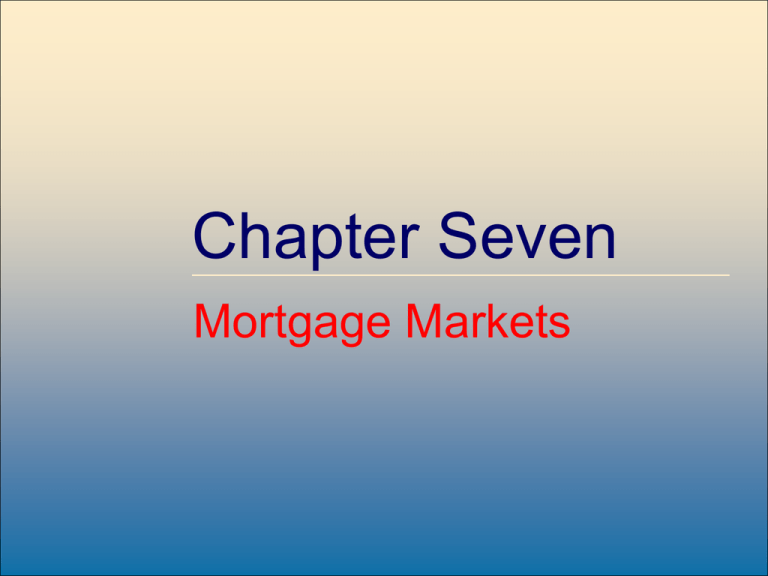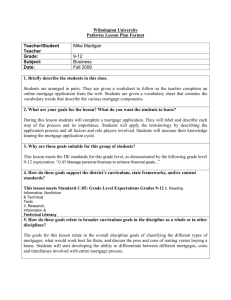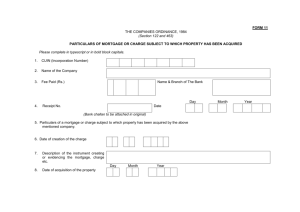
Chapter Seven
Mortgage Markets
McGraw-Hill /Irwin
7-1
Copyright © 2004 by The McGraw-Hill Companies, Inc. All rights reserved.
Mortgages and Mortgage-Backed
Securities
• Mortgages are loans to individuals or businesses
to purchase a home, land, or other real property
• Many mortgages are securitized
– mortgages are packaged and sold as assets backing a
publicly traded or privately held debt instrument
• Four basic categories of mortgages issued
– home, multifamily dwelling, commercial, and farm
McGraw-Hill /Irwin
7-2
Copyright © 2004 by The McGraw-Hill Companies, Inc. All rights reserved.
Mortgage Loans Outstanding, 2001 ($Bn)
$461$116
$1,323
$5,757
family
McGraw-Hill /Irwin
commercial
7-3
multifamily
farm
Copyright © 2004 by The McGraw-Hill Companies, Inc. All rights reserved.
Mortgage Characteristics
• Lien - a public record attached to the title of the
property that gives the FI the right to sell the property if
the mortgage borrower defaults
• Down payment - a portion of the purchase price of the
property a FI requires the mortgage borrower to pay up
front
• Private mortgage insurance - insurance contract
purchased by a mortgage borrower guaranteeing to pay
the FI the difference between the value of the property
and the balance remaining on the mortgage
(continued)
McGraw-Hill /Irwin
7-4
Copyright © 2004 by The McGraw-Hill Companies, Inc. All rights reserved.
• Federally insured mortgages - originated by FIs with
repayment guaranteed by either the Federal Housing
Administration (FHA) or the Veterans Administration
(VA)
• Conventional mortgages - issued by FIs that are not
federally insured
• Amortized - when the fixed principal and interest
payments fully pay off the mortgage by its maturity
date
• Balloon payment mortgages: requires a fixed monthly
interest payment for a three- to five-year period with
full payment of the mortgage principal required at the
end of the period
(continued)
McGraw-Hill /Irwin
7-5
Copyright © 2004 by The McGraw-Hill Companies, Inc. All rights reserved.
• Fixed-rate mortgage - locks in the borrower’s interest
rate and thus the required monthly payment over the life
of the mortgage, regardless of market rate changes
• Adjustable-rate mortgage - where the interest rate is tied
to some market interest rate with potential for change in
required monthly payments over the life of the
mortgage
• Discount points - interest payments made when the loan
is issued (at closing). One discount point = 1 percent of
the principle value of the mortgage
• Amortization schedule - schedule showing how the
monthly mortgage payments are split between principal
and interest
McGraw-Hill /Irwin
7-6
Copyright © 2004 by The McGraw-Hill Companies, Inc. All rights reserved.
Calculation of Monthly Mortgage
Payments
PV = PMT(PVIFA i/12, n 12)
Where:
PV =
PMT =
PVIFA =
i =
n=
McGraw-Hill /Irwin
Principal amount borrowed through the mortgage
Monthly mortgage payment
Present value interest factor of an annuity
Annual interest rate on the mortgage
Length of the mortgage in years
7-7
Copyright © 2004 by The McGraw-Hill Companies, Inc. All rights reserved.
Comparison of Monthly Mortgage
Payments
$150,000 home with 30-year mortgage at 8%, 0 points, 20% down
$120,000 = PMT(PVIFA 8%/12, 30 12 )
PMT = $120,000/136.2835 = $880.52
$150,000 home with 15-year mortgage at 8%, 0 points, 20% down
$120,000 = PMT(PVIFA 8%/12, 15 12 )
PMT = $120,000/104.6406 = $1146.78
McGraw-Hill /Irwin
7-8
Copyright © 2004 by The McGraw-Hill Companies, Inc. All rights reserved.
Other Types of Mortgages
• Automatic rate-reduction mortgages - where the lender
automatically lowers the rate on an existing mortgage
when prevailing rates fall
• Graduated-payment mortgages - where borrowers make
small payments early in the life of the mortgage,
increased payments over the first 5-10 years and level
off at the end of the mortgage period
• Growing-equity mortgages - where the initial payments
are the same as a conventional mortgage but increase
over a portion or the entire life of the mortgage
(continued)
McGraw-Hill /Irwin
7-9
Copyright © 2004 by The McGraw-Hill Companies, Inc. All rights reserved.
• Second mortgages - loans secured by a piece of real
estate already used to secure a first mortgage
• Home equity loan - loans that let customers borrow on a
line of credit secured with a second mortgage
• Shared-appreciation mortgage (SAM) - allows a home
buyer to obtain a mortgage at an interest rate below
current rates in exchange for a share in any appreciation
of the property
• Equity-participation mortgage - similar to SAM except
that an outside investor shares in the appreciation
• Reverse-annuity mortgage - where mortgage borrower
receives regular monthly payments from a FI
McGraw-Hill /Irwin
7-10
Copyright © 2004 by The McGraw-Hill Companies, Inc. All rights reserved.
Secondary Mortgage Market
• Advantages for FI to securitize
– reduces liquidity risk, interest rate risk, and credit risk of
FIs portfolio
– FI retains income from origination fees and service fees
• FI’s remove mortgages from their balance
sheet through one of two mechanisms
– pool recently originated mortgages together and sell
them in the secondary market
– issue mortgage-backed securities that are backed by
their newly originated mortgages
McGraw-Hill /Irwin
7-11
Copyright © 2004 by The McGraw-Hill Companies, Inc. All rights reserved.
History of Secondary Mortgage Markets
• Federal National Mortgage Association (FNMA or
“Fannie Mae”) created during the Great Depression
• FHA and VA insured loans also created during this time
• Government National Mortgage Association (GNMA or
“Ginnie Mae”) and Federal Home Loan Mortgage
Corp. (FHLMC or “Freddie Mac”) created during
1960’s
• Wide variety of mortgage-backed securities have been
developed and in 1999, approximately 50% of
mortgages are securitized
McGraw-Hill /Irwin
7-12
Copyright © 2004 by The McGraw-Hill Companies, Inc. All rights reserved.
Mortgage Sales
• Mortgage sale - sale of a mortgage originated by a bank with
or without recourse to an outside buyer
• Allow FIs to manage credit risk and achieve better asset
diversification, improves their liquidity risk
• FIs are encouraged to sell loans for economic (generate fee
income) and regulatory reasons (reducing reserve req’s)
• Major buyers of mortgage loans are domestic banks, foreign
banks, insurance companies and pension funds, closed end
bank loan funds, and nonfinancial firms
• Major sellers of mortgage loans are money center banks,
smaller banks, foreign banks, investment banks
McGraw-Hill /Irwin
7-13
Copyright © 2004 by The McGraw-Hill Companies, Inc. All rights reserved.
Securitization of Mortgages
• Pass-through mortgage securities - mortgage-backed
securities that “pass-through” promised payments of
principal and interest on pools of mortgages created by
financial institutions to secondary market participants
holding interests in the pools
• Issued in standard denominations, usually $25,000 with
increments of $5,000 beyond the minimum
• Three government owned or sponsored agencies
involved - Ginnie Mae (GNMA), Fannie Mae (FNMA,
and Freddie Mac (FHLMC)
McGraw-Hill /Irwin
7-14
Copyright © 2004 by The McGraw-Hill Companies, Inc. All rights reserved.
Government-Related Mortgage-Backed
Pass-Through Securities Outstanding ($Bn)
1400
1200
1000
800
600
400
200
0
1995
GNMA
McGraw-Hill /Irwin
1997
FNMA
1998
FHLMC
7-15
2000
2001
Private Mortgages
Copyright © 2004 by The McGraw-Hill Companies, Inc. All rights reserved.
Collateralized Mortgage Obligations
• CMO - a mortgage-backed bond issued in
multiple classes or tranches
– tranches - a bond holder class associated with a CMO
• Created by packaging and securitizing whole
mortgage loans or resecuritizing pass-through
securities
• Attractive to secondary mortgage market
investors because they can choose a particular
CMO class that fits their maturity needs
McGraw-Hill /Irwin
7-16
Copyright © 2004 by The McGraw-Hill Companies, Inc. All rights reserved.






